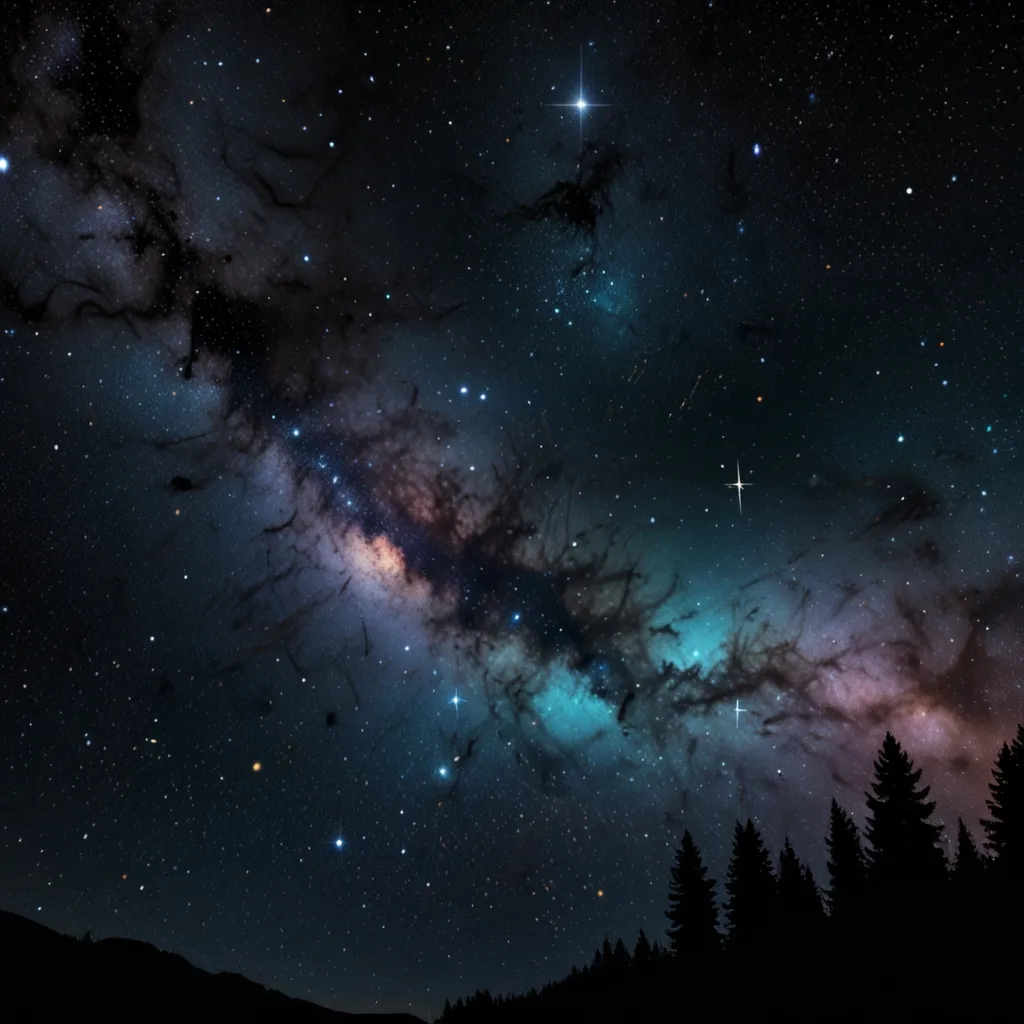Every starlit night is like peering into a cosmic history book, each glittering point telling a tale older than our planet. Isn’t it wild to think that every twinkle you see is not just a distant sun, but a powerhouse of energy shaping life and matter? From the blazing surfaces of stars to the mind-blowing explosions of supernovae that briefly outshine entire galaxies, the universe is like a live-action science fiction movie.
Let’s talk about some of the universe’s heavyweight champions. Each one of these cosmic phenomena helps us piece together the grand narrative of the cosmos. We’re unraveling the history of every atom, planet, and living thing. It’s all connected. Here’s a dive into the most powerful players up there in the sky.
Black Holes
First on the list: black holes. These aren’t your regular celestial objects; they are cosmic enigmas with gravity so intense that once you cross the point of no return—the event horizon—not even light can escape. Imagine a massive object squeezed into a space so tiny that it creates a gravity field strong enough to tear apart stars.
What’s cool about black holes is despite being invisible (you can’t see them directly because light can’t escape), they make themselves known through their dramatic effects on surrounding matter. Matter spiraling into a black hole forms what’s called an accretion disk, glowing bright as it gets superheated and emits light across a spectrum of wavelengths. It’s like a cosmic lighthouse in space.
We’ve got all these different ways to study black holes. Gravitational lensing, for instance, is when light from distant stars bends around a black hole, kind of like a funhouse mirror. And then there are gravitational waves—ripples in spacetime that spread out when massive objects like black holes collide and merge.
Now, let’s not forget supermassive black holes (SMBHs). These giants, like the one in the galaxy Ton 618, are a paradox. Despite their humongous mass, the average density inside the event horizon can be less than water, thanks to the mind-bending way black holes stretch space. These cosmic monsters stretch the surrounding space so much that their overall volume becomes unimaginably vast.
It’s incredible that nearly every large galaxy, including our Milky Way, has a supermassive black hole at its center. The relationship between these black holes and their host galaxies hints at a mysterious coevolution process we’re just beginning to understand.
Black holes are a playground for physicists, defying our conventional understanding of gravity and mass. They are like cosmic laboratories where the rules of physics are pushed to the extreme. Our ongoing research keeps peeling back the layers of these dark enigmas, continuously surprising us with their dynamic nature.
Neutron Stars and Pulsars
Next up, neutron stars. These cosmic oddballs are what’s left behind after a supernova—a massive star collapsing under its own gravity, creating something so dense that a sugar-cube-sized amount would weigh a billion tons on Earth. Imagine compressing twice the mass of our Sun into something only about 20 kilometers across. Mind-blowing, right?
Pulsars are a special kind of neutron star. These guys spin at ludicrous speeds, emitting beams of electromagnetic radiation from their magnetic poles. It’s like a lighthouse that emits pulses of light; only these pulses can be radio waves, X-rays, or even gamma rays. Jocelyn Bell Burnell discovered the first one back in 1967, and it was a real game-changer, proving neutron stars existed.
Pulsars are phenomenal precision clocks. Some spin hundreds of times per second. They’re so regular they help us test theories of gravity and even hunt for gravitational waves. Imagine binary pulsars—two neutron stars orbiting each other. They give us critical tests of Einstein’s theories, especially about gravitational waves.
Neutron stars pack more than just dense matter—they radiate gravitational waves and offer glimpses into the extreme state of matter. They’re dense, fast-spinning objects that help us understand nuclear physics and quantum mechanics under conditions we can’t replicate on Earth.
Scientists also study magnetic neutron stars called magnetars with extraordinarily strong magnetic fields, and millisecond pulsars that have been spun up by material from a companion star. Each type challenges and refines our understanding of physics under the most extreme conditions imaginable.
Gamma-Ray Bursts (GRBs)
On to the next heavy hitter: gamma-ray bursts. These cosmic fireworks are the most violent and luminous events in the universe. A burst can emit more energy in a few seconds than the Sun will in its entire lifetime! They come in two flavors: long-duration and short-duration bursts.
Long GRBs are usually linked to the collapse of massive stars, leading to supernovae or hypernovae which are super-powerful star explosions. Short GRBs, on the other hand, come from the merger of binary neutron stars or a neutron star merging with a black hole. These mergers don’t just emit gamma rays; they also produce gravitational waves and heavy elements like gold and platinum.
Take GRB 221009A, for example, detected in October 2022. This GRB was off the charts—about 50 to 70 times brighter than any previous ones detected. It’s so significant that it’s become the most studied gamma-ray burst in history. It emitted an insane amount of energy, confirming just how explosive and rare these events are.
Studying such incredible energies and emissions helps refine our cosmic models. They push our understanding to its limits, revealing phenomena we didn’t even know existed.
Quasars and Active Galactic Nuclei
Now let’s talk quasars and active galactic nuclei (AGNs). These brilliant objects are the universe’s shining beacons, powered by supermassive black holes at the centers of galaxies. As material falls into these massive black holes, it forms a glowing accretion disk, emitting light across a huge range of wavelengths.
Quasars are the most energetic type of AGNs, visible billions of light-years away. They represent the hyperactive centers of distant galaxies where supermassive black holes consume matter at incredible rates, emitting a tremendous amount of energy.
The discovery of quasars began with radio astronomy, identifying far-off radio sources back in the 1950s and 60s. Maarten Schmidt’s 1963 revelation tied a quasar redshift to distant galaxies, exploding our understanding of the universe.
AGNs and quasars help us peer into the early universe, showing us the extremes of energy and gravity. They’re vital for studying galaxy formation and evolution. Observing quasars with advanced telescopes like Hubble allows us to see conditions as they were soon after the Big Bang.
The study of these celestial giants continues to expand our horizons. They offer a window into the dynamics of galaxies and their central black holes, illuminating our understanding of cosmic history.
Cosmic Microwave Background (CMB)
Last but not least, we have the cosmic microwave background. The CMB is like the universe’s baby picture, the afterglow from the Big Bang. This radiation envelops the cosmos, providing a snapshot of the universe 380,000 years after its birth when it first became transparent to photons.
Penzias and Wilson’s 1965 discovery of the CMB was groundbreaking, solidifying the Big Bang theory. The tiny fluctuations in the CMB map out the distribution of matter in the early universe, leading to the galaxies and structures we see today.
These fluctuations and the study of CMB polarization (light twisting due to the universe’s expansion) give us clues about the universe’s infancy, including possible evidence of inflation—an unimaginably rapid expansion following the Big Bang.
Satellites and observatories like COBE, WMAP, and Planck have refined our CMB measurements, providing deep insights into the universe’s composition and the processes shaping its evolution. Studying the CMB remains a cornerstone of cosmology, weaving together theoretical physics, astrophysics, and cutting-edge technology.
Each of these celestial phenomena helps us understand the vast story of our universe—a tale crafted by immense forces and ancient light. They teach us about the fundamental principles of the cosmos and inspire our continuous pursuit of knowledge. These cosmic clues remind us of the universe’s complexity and the incredible drive to explore the unknown.






